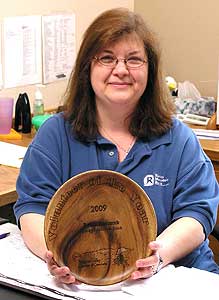 |
|
||||||||||||

|
|||||||||||||
|
|||||||||||||
|
Wednesday, April 7, 2010 Page One News at a GlanceBRASS program offers unique opportunity for kidsSanctions against Robaks could top $100,000Fees awarded in Mitchell Slough caseCaffe Firenze is Business of YearGravel pit draws complaintsBRASS program offers unique opportunity for kidsBy Michael Howell Every year members of the staff at Rocky Mountain Laboratory in Hamilton participate in what has become a very successful after school teaching program in the local middle schools, called the Biomedical Research After School Scholars program (BRASS). Visiting scientists from around the world, many doing post doctoral work at the lab, as well as permanent RML staff scientists, volunteer to teach in the after school program and each year a series of teams present the program at two or three valley schools. The once a week sessions, held over a period of four to five weeks, involve a lot of hands-on lab experience focused on cutting-edge science—genetics, infectious diseases, neurology, immunology, animals in research, analytical chemistry, and more. Student participation is also voluntary and the program has been steadily growing over the years. The program is designed to accommodate the whole spectrum of students from gifted and talented to those with special needs. The paradigm for the after school teaching program was first developed at the National Institutes of Health’s main national campus located in Bethesda, Maryland. That program, although sporting the same acronym, BRASS, was named the Biomedical Research Advancement: Saturday Scholars program. In that program students from middle schools around the Washington D.C. area would travel to the laboratory campus on Saturdays for the structured learning program and laboratory training. Rocky Mountain Laboratory’s Associate Director Marshall Bloom, M.D. discovered the program when he was visiting the NIH main campus in Maryland in 1998. “I figured this was something RML could bring to Hamilton and schools in the Bitterroot Valley but on a much simpler scale,” Dr. Bloom is quoted as saying on the NIH web site about the program. The idea took hold immediately with people like Elizabeth Fischer, the electron microscopist; microbiologist Kit Tilly, Ph.D., a Lyme disease researcher; and visual arts specialist Anita Mora. Brainstorming sessions quickly began with local school faculty members and administrators. What emerged was a slightly different program than the big city model. In the Bitterroot it is the lab scientists that travel to the schools instead of students traveling to the lab. Initially it involved only one scientist from the lab teaching each session, now it involves four scientists per session. Since 1998 over 100 RML scientists have participated in the program locally and close to 600 students have graduated from the program in the Bitterroot Valley. Some of those graduates have gone on to become scientists in the field of biomedical research themselves. A few are even currently working at the lab. The course curriculum changes as scientists with different interests and specialties decide to participate. This year BRASS classes were held at Corvallis and Stevensville and included sessions on Cell Biology, Immunology/Allergies, Infectious Diseases, Forensics and Animals in Research. About twenty-two RML scientists participated in the program this year. |
||||||
Sanctions against Robaks could top $100,000By Michael Howell The lawsuit filed against Ravalli County by Tom and Charlotte Robak over enforcement of floodplain regulations is slowly inching its way through the system. The Robaks filed suit in August of 2008 after receiving a letter from the county asking them to cease and desist working on the million dollar plus home they were building on the banks of the West Fork of the Bitterroot River. The county was concerned that the Robaks had violated the floodplain regulations by bringing in fill to raise the property out of the floodplain. At least one order on preliminary motions has already been issued by District Court Judge James Haynes in the case. In it he dismissed several claims made by the Robaks. But he also found that the footprint of the couple’s home was not in the floodplain although portions of the garage were. He ordered further testing to be done by the county. He also slapped the Robaks with Title 11 sanctions for “misrepresentations of material facts.” The couple had provided testimony and affidavits that they had not placed any fill in the floodplain where the home is being constructed. But the county presented evidence that a hundred truckloads of fill had been brought on to the site by contractors working for the Robaks. The hearing on Tuesday, March 30, was aimed at establishing how much the Robaks owe the county for past and future work investigating, uncovering and disproving the false claims. There was testimony that the county spent close to $26,265 in clerical and contract work. County Attorney George Corn argued that county attorneys involved in the case should receive the same as a private attorney would receive for such work. He supplied a witness who testified that the average prevailing rate for private attorneys would be about $185 per hour. If the court goes along with that claim the fees sought could total over $100,000. Dustin Chouinard, attorney for the Robaks, asked for and a received a continuance of the hearing until Tuesday, May 4, at 9 a.m., so that he could study the county’s claim for fees. He noted that Haynes’ ruling required that the Robaks pay only for “the unnecessary expenditure of taxpayer resources.” He said that he would need to examine the county’s claims to see if the fees requested were related directly to matter of the sanction and not on some other aspect of the case which is still headed to trial. He will also probably argue that the County Attorneys should only be paid at their regular public hourly rate and not at the going private rate. Haynes noted that he had already dismissed several of the claims made by the Robaks in their lawsuit. Those claims had to do with alleged violations of the Robaks’ constitutional rights, and their right to peaceably enjoy the use of their property, that the county acted negligently, and that the county had already implicitly approved the construction of the house by approving a septic permit. The Robaks’ claim for punitive damages was also dismissed. The county has filed counter claims against the Robaks, including claims for punitive damages, which will proceed to trial. At Tuesday’s hearing Haynes also reiterated that the county’s floodplain regulations were flawed in that they did not provide for any action of relief if a person failed to apply for a floodplain permit. As a result the only remedy left to either party was to go to court. He said that the Robaks rolled the dice when they began building without a permit and took the chance that they might be caught. |
|||||||
Fees awarded in Mitchell Slough caseOn December 2, 2009, Missoula District Court Judge awarded attorney fees in the Mitchell Slough case to the Bitterroot River Protection Association (BRPA) under the private attorney general doctrine. Under that doctrine if the state fails to act to protect the public’s interest, forcing a citizen or citizen’s group to take court action to see the law implemented, then that citizen or group should get attorney’s fees reimbursed if they are successful. In this case the BRPA, which prevailed in the landmark stream access and environmental protection case, was asking for attorney’s fees of $354,645.65. The Court held a hearing on March 8, 2010 to determine if those fees were reasonable. Following the hearing, on March 25, Judge Deschamps awarded BRPA a slightly reduced amount of $319,405.65 in legal fees. In determining the reasonableness of the fees, Deschamps applied what are called the seven “Plath factors,” factors arrived at in the case of Plath v. Schonrock, a 2003 court case in which the Court first developed the seven criteria used as guidelines for ascertaining the “reasonableness” of attorney fees. The factors to be considered include the amount and character of the services rendered, the labor, time and trouble involved, the character and importance of the litigation, the amount of money or the value of the property to be affected, the professional skill and experience called for, the attorney’s character and standing in their profession, and the results secured by the services of the attorney. The landowners argued that none of the Plath factors were satisfied in this case. But as the Court points out, the landowners later assert that “there is no dispute that the labor, time, and trouble involved in this case were significant for both parties (Plath factor 2); that BRPA’s counsel has the professional skill and expertise required (Plath factor 5); or that BRPA’s counsel has good character and standing in the legal profession (Plath factor 6).” Also there is no argument about the results being successful in the case. But concerning Plath factor 4, “the value of the property to be affected,” the Landowners argue the claims in this case “involved no monetary claims and affected no value of property owned by the BRPA.” “The Court disagrees with the landowner’s narrow interpretation,” wrote Deschamps. “The ‘value of the property to be affected’, specifically public access to Mitchell Slough, is significantly increased as a result of BRPA’s efforts. The public’s right to fish, float and recreate on the Mitchell is now preserved, something of great value to all Montanans and originating in the Montana Constitution itself.” Deschamps then quotes his December 2, 2009 decision, “The public’s right to use natural watercourses for recreation, derives from Article IX, 3(3) of the Montana Constitution where, ‘all surface, underground, flood, and atmospheric waters within the boundaries of the state are the property of the state for the use of its people.’ The public’s right to use all Montana waters exists as an independent constitutional right.” Deschamps notes that BRPA affirmatively met all the Plath factors. He concludes, “Rather than finding BRPA’s fees are ‘bloated and excessive’, as the landowners argue, the Court finds, under the unique facts of this case, and under Plath, the fees are reasonable.” Since the BRPA lost on count one of the case, and the Bitterroot Conservation District Board was found to have immunity in the case, and Count four, concerning state ownership of the riverbed, was dismissed, the landowners argued that the time spent on those counts should not be part of the award. Deschamps agreed and subtracted $33,980 from BRPA’s claim. He also reduced it by $1,260 in clerical fees that were deemed unrelated to the successful counts, bringing the final award amount down from $354,645.65 initially requested to $319,405.65. The landowners also argued that any attorney fees on the stream access portion of the case should not be counted after FWP joined the case since from that point on the state was involved and the private attorney general doctrine should not apply. Deschamps states that “but for BRPA’s challenge to the BCD’s determination that Mitchell Slough was exempt from 310 Law, ‘the BCD’s decision would stand.’ BRPA states that no government entity was willing to challenge the BCD’s decision, not FWP, due to Governor Martz’s prohibition, nor Ravalli County, or any other entity. According to BRPA, the same is true for the Stream Access case, where the only reason FWP participated was because this Court ordered it to appear as an involuntary plaintiff.” Deschamps states that both the record and the testimony at the March 8 hearing “support the finding that BRPA contributed in a significant way to the vindication of an important constitutional and statutory right, rendered necessary and significant services of value to the public which were not duplicative of those advanced by FWP and actively participated throughout in the prosecution of the case.” In conclusion Deschamps declines to apportion the fees based upon FWP’s involvement. “BRPA’s initiation of this case and tireless efforts in seeing it through to a successful appeal support a full award of fees,” concluded Deschamps. |
|||||||
Caffe Firenze is Business of YearThe Bitterroot Valley Chamber of Commerce presented annual awards at its recent banquet BUSINESS OF THE YEAR Caffe Firenze, an Italian food restaurant in Florence (Montana, not Italy), has been selected by the Bitterroot Chamber of Commerce to receive the Business of the Year Award for 2009. The restaurant is owned and operated by Patti and John Stevens. They not only own and operate it, they created it. Both of them grew up in Hamilton but then embarked on professions that took them elsewhere, mainly to major cities. John worked at starting up companies mainly in the telecommunications industry and Patti was an interior designer for commercial buildings. The desire to eventually return to the Bitterroot was something they shared. They bought land here in 2004 but weren’t planning on making the move until their daughters graduated. But the time came and they made the move. Putting their skills together and spurred by a niece that was an Italian cuisine chef they decided to create a little Italy in Florence. According to John, he has a little of the restaurant business in his blood as well. His parents ran the Loose Caboose in Hamilton until they sold it in the 1980s. “We wanted to accomplish three things,” said John. “We wanted a warm friendly atmosphere, to offer premier customer service, and to have some great tasting cuisine.” Patti said that she dropped her jaw when she was told at the Chamber banquet, which she was catering, to come out of the kitchen and accept an award. “It was a huge surprise and a nice honor,” said Patti.
“I’ve been involved in horses all my life,” said Manzella. “My parents expected me to grow up and get over horses, but I never did.” Manzella has won 15 state titles in Reigning and a national title as well. Manzella started a program called Cowkids for Christ, a ten-lesson program for 3- to 19-year-olds. She is also founder and president of Willing Servants, a non-profit horse care network that was recently awarded custody of the abused horses that were confiscated by the County from the abusing owners following a trial in District Court. Manzella also sits on the Chamber’s Agri-Business Committee.
“I liked my experience in Great Falls so I decided to do this,” said Verbera. He said that he and his wife, Amber, both work full time at the restaurant and have really enjoyed it. “Stevensville is a nice community and we love being here,” he said.
“Our Economic Development Award goes to a person or business that is working tirelessly to promote economic development in the valley,” said Pat Easley of the Bitterroot Chamber of Commerce. Darby Distribution was originally founded in 1976. The company was purchased by the Dembiskys in 1983 and turned into a full service lumber yard and hardware store. In 2006, a new “state of the art” truss plant opened and in 2008 the doors were opened on a new 15,000 square foot building. The company currently employs over 30 people. The Unsung Hero Award went to Mike McConnell of GAP Broadcasting. |
|||||||
Gravel pit draws complaintsBy Michael Howell Over a dozen landowners northeast of Stevensville along the Eastside Highway have signed a letter of complaint to the County Commissioners about a gravel pit operation being conducted on property owned by Arlo Ellison. According to the letter, the area is currently being leased and operated as a gravel pit by T & T Contracting of Victor. The letter, written on March 28, claims that work at the gravel pit has been routinely starting before dawn and extending past 5 p.m., sometimes as late as 7 p.m., including Saturdays and Sundays, for a minimum of 70 hours per week with at least five crushers operating simultaneously. “My wife and I find it unbearable to be outside on our property during operation of the gravel pit, and indeed find it difficult to even be inside our house,” states Robert Gensemer, the organizer of the petition. “The noise level is deafening, and the vibration of the ground penetrates through the foundation of our house. We are experiencing mental and emotional stress, and possibly negative effects on our health.” Gensemer states that a week prior to writing the letter the crushers and most of the heavy equipment was removed from the site. But he states that operations at the site have been suspended temporarily in times past only to return later. He claims to fear that the operation will be started up again. Both Ellison and a spokesperson at T & T Contracting said on Monday that they were unaware of any complaints about the gravel pit. Gravel operations are permitted by the Department of Environmental Quality. Chris Cronin, Supervisor of the DEQ Open Pit Mining Program, also said that he was unaware of any complaints about the gravel pit operation at this time. Cronin said that the permit, originally set to expire in December of 2010, was recently extended for five years and is now set to expire in 2015. He said no changes were made to the existing permit except the extension of the timeline. Cronin said that the permit for this project does contain the typical restrictions on working times for all equipment, which are from 7 a.m. to 7 p.m., Monday through Friday. However, the permit includes a possible exception when the mine may be operated from 6 a.m. to 10 p.m. Monday through Saturday for a period not to exceed 15 consecutive working days. The exception cannot be invoked again for 90 days. Maintenance activities may take place at any time, said Cronin. Cronin said that the appropriate procedure for registering a complaint about activities at a permitted gravel mining operation would be to call the DEQ Enforcement Division or to file a complaint online at the agency’s website at www.deq.state.mt.us. |
|||||||




